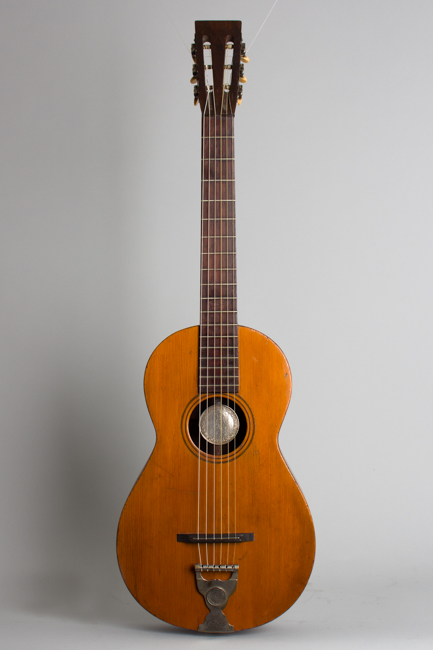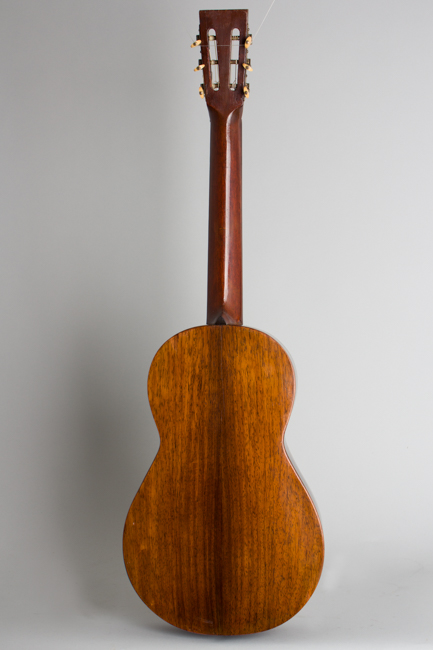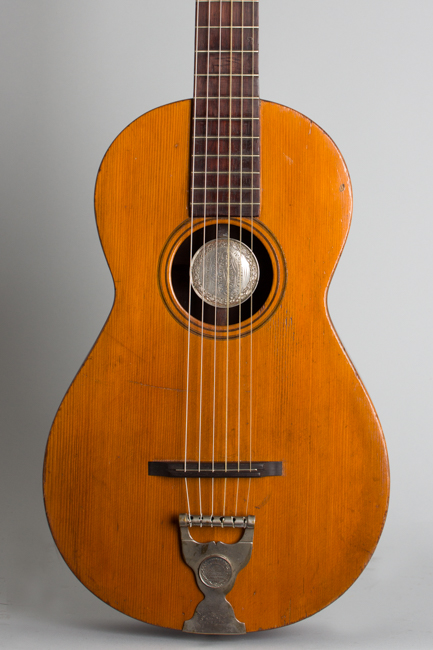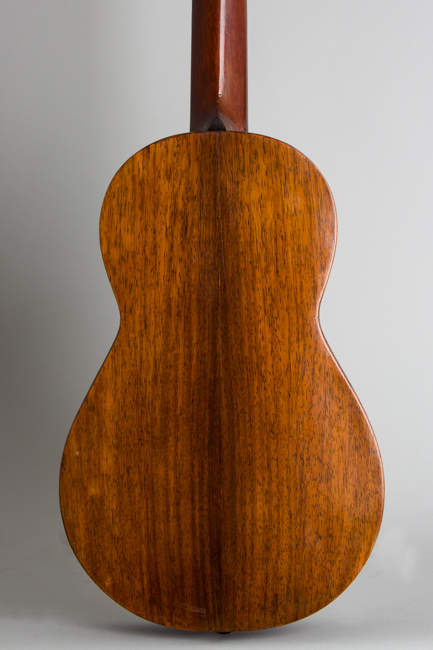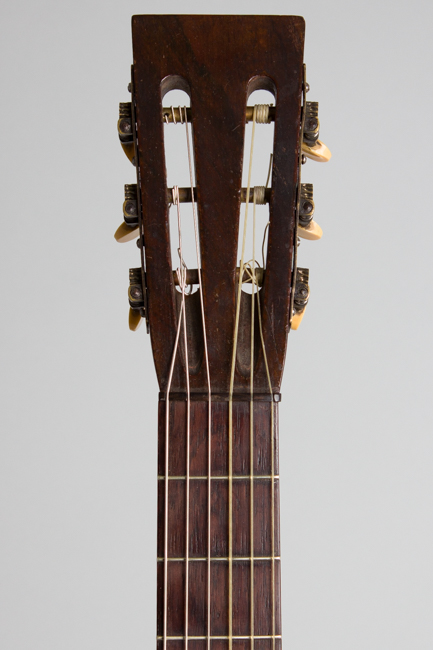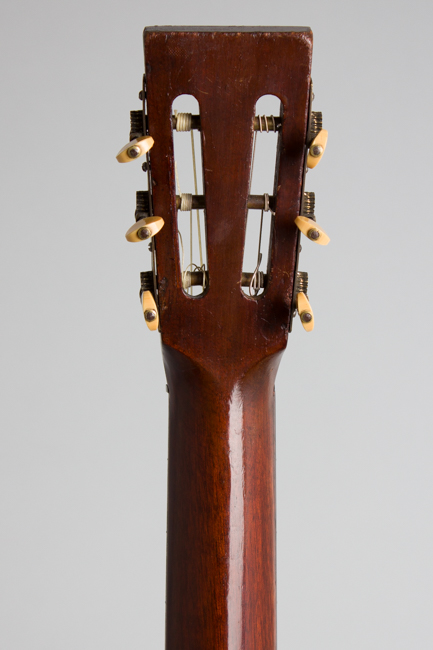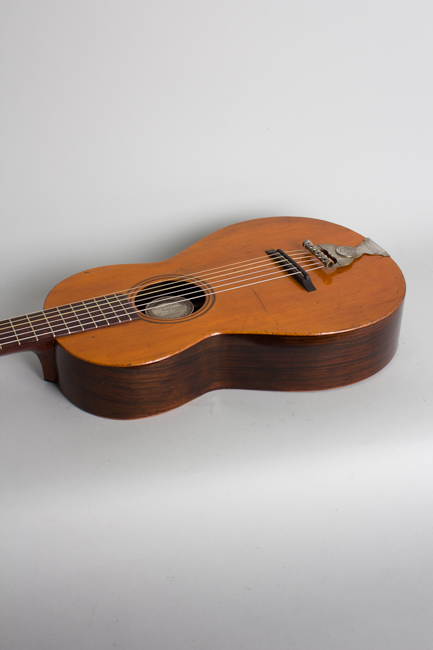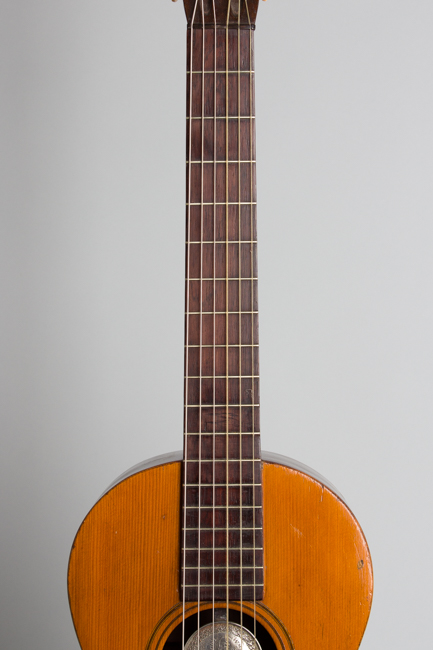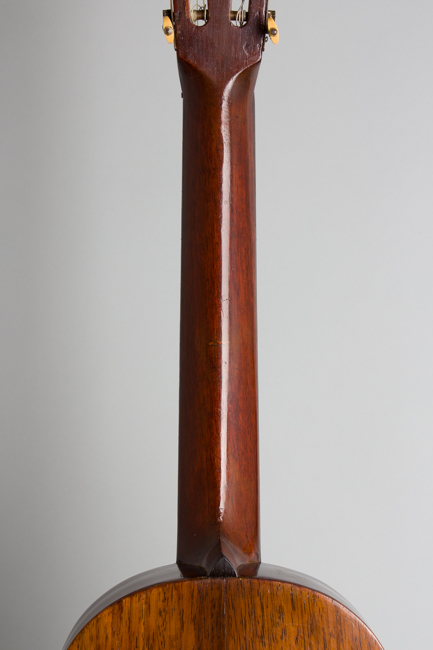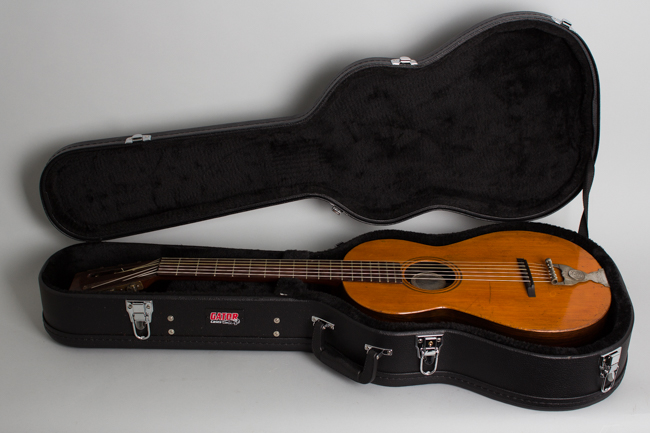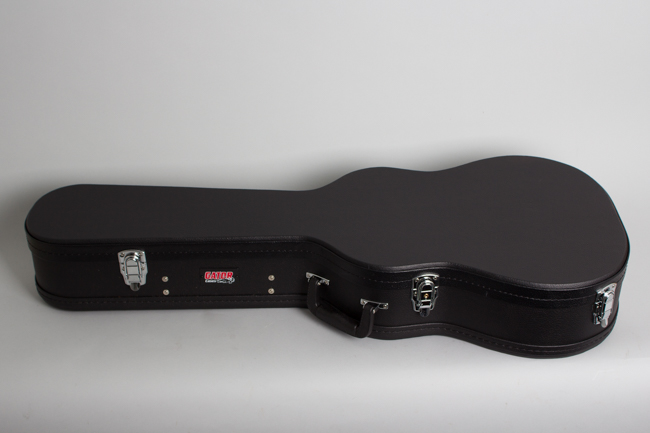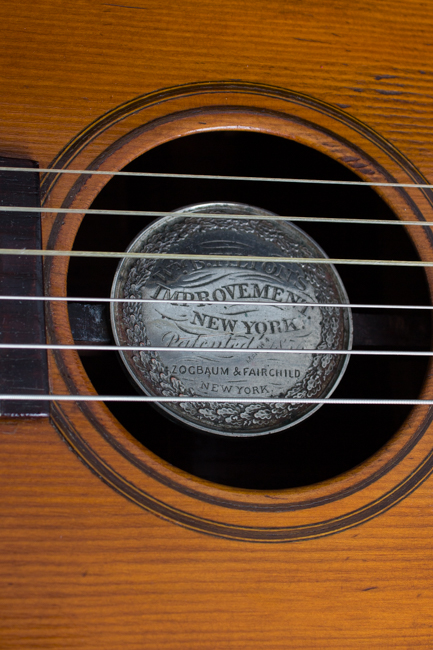Wm. B. Tilton Style # 0 Flat Top Acoustic Guitar, made by John C. Haynes , c. 1875
This item has been sold.
Item # 9979
Prices subject to change without notice.
Wm. B. Tilton Style # 0 Model Flat Top Acoustic Guitar, made by John C. Haynes, c. 1875, probably Boston, natural varnish finish, Brazillian rosewood sides, rosewood back, spruce top, mahogany neck with rosewood fingerboard, black tolex hard shell case.
This fascinating nineteenth century guitar has seen a lot of work performed over the past 150 years or so, but remains a lovely playable instrument from one of the era's more celebrated designers. William B. Tilton was certainly an original thinker; his patented "Improvements" to the guitar consisted of a wooden center bar that ran down the inside of the guitar like the dowel of a banjo, intended to relieve the main stresses of string tension stress on the top.
Other novel design elements include a conspicuous metal tailpiece feeding a string-through wooden bridge. Tilton's parentage is stamped both on the tailpiece itself and the curious metal disc suspended on the center strut visible the soundhole, which touted the 1856 patent on these innovations. Whether or not these "improvements" actually resulted in a better guitar, this is an absolutely distinctive very well-crafted little guitar with a vibrant tone.
The sides of this guitar are beautifully grained Brazilian rosewood; the back is also rosewood of a very different character and grain and appears to have been replaced fairly early in the guitar's life. The spruce top is unbound, with the grain run straight in the standard manner; many of the fancier Tilton instruments use an unusual diagonal grain top which tends to be less stable over time, and is often badly cracked by now. The neck is mahogany with a dark rosewood fingerboard, ebony nut and brass plate tuners with early celluloid buttons. The tuners are period but may not be original to the guitar.
The elaborately decorated "Tilton's Improvement" disc in the soundhole bears the patent date of March 4th, 1856 and the distributor's mark of "Zogbaum and Fairchild, New York". The nickel-plated tailpiece is one of several versions, this one is the most distinctive with a large tubular bar the strings wrap under. Beneath this is another Zogbaum and Fairchild marked disc, touting an 1865 award "For The Best guitars" with a border nicely engraved in a floral pattern. The tailpiece also bears the mark of the John C. Haynes & Co. of Boston, who secured the rights to built and sell "Tilton's Improvement" guitars for some years in the mid-late 19th century.
This guitar is sturdily built for its age, very playable with a sweet sound and can be well-recommended for use in situations such as Civil War re-enacting or authentic Western or minstrel re-creations where an accurate and functional 1860s style guitar is a requirement. It plays well with authentic gut strings as intended and includes a modern hardshell case.
Overall length is 36 1/4 in. (92.1 cm.), 11 5/8 in. (29.5 cm.) wide at lower bout, and 3 3/8 in. (8.6 cm.) in depth at side, taken at the end block. Scale length is 24 1/4 in. (616 mm.). Width of nut is 1 3/4 in. (44 mm.).
This guitar is far from pristine but is actually a fine playing instrument, which is not always the case with guitars of this antique vintage. There has been a lot of repair work, some of appearing decades or even a century old. The back is most likely a replacement, but appears to have quite a bit of age to it. The rosewood looks similar in grain and density to some we have seen on 1930's Martins. This may have been done due to damage or simply due to interior work which is difficult otherwise given the unusual construction of these guitars. There is a repaired crack down the upper center of this back piece, another parallel to it closer to the treble side and several more on the lower bouts.
The rosewood fingerboard is also a replacement; it also has some age to it but is slightly radiused unlike a typical 19th century fingerboard. A shim has been added underneath the fingerboard, touched up to match the original mahogany neck. The small-wire frets appear older but not 19th century pattern. There is a repaired crack through the very thin heel, probably the result of a neck reset performed decades ago. The bridge is a modern replacement made in the original style.
The finish is original on the top, sides and neck with some touch ups mostly related to the repairs. There is micro-checking, dings dents and scrapes overall but only some fairly minor playwear for 150+ years. The guitar is currently strung with authentic gut strings for the most period-correct experience, but in our experience Tilton's design makes his instruments adaptable to silk & steel stringing if desired, which is not true of most 19th century guitars. This guitar is a real survivor, and has obviously had an eventful life since the industrial revolution was new but remains a delightful historic and fully playable instrument. Excellent - Condition.
This fascinating nineteenth century guitar has seen a lot of work performed over the past 150 years or so, but remains a lovely playable instrument from one of the era's more celebrated designers. William B. Tilton was certainly an original thinker; his patented "Improvements" to the guitar consisted of a wooden center bar that ran down the inside of the guitar like the dowel of a banjo, intended to relieve the main stresses of string tension stress on the top.
Other novel design elements include a conspicuous metal tailpiece feeding a string-through wooden bridge. Tilton's parentage is stamped both on the tailpiece itself and the curious metal disc suspended on the center strut visible the soundhole, which touted the 1856 patent on these innovations. Whether or not these "improvements" actually resulted in a better guitar, this is an absolutely distinctive very well-crafted little guitar with a vibrant tone.
The sides of this guitar are beautifully grained Brazilian rosewood; the back is also rosewood of a very different character and grain and appears to have been replaced fairly early in the guitar's life. The spruce top is unbound, with the grain run straight in the standard manner; many of the fancier Tilton instruments use an unusual diagonal grain top which tends to be less stable over time, and is often badly cracked by now. The neck is mahogany with a dark rosewood fingerboard, ebony nut and brass plate tuners with early celluloid buttons. The tuners are period but may not be original to the guitar.
The elaborately decorated "Tilton's Improvement" disc in the soundhole bears the patent date of March 4th, 1856 and the distributor's mark of "Zogbaum and Fairchild, New York". The nickel-plated tailpiece is one of several versions, this one is the most distinctive with a large tubular bar the strings wrap under. Beneath this is another Zogbaum and Fairchild marked disc, touting an 1865 award "For The Best guitars" with a border nicely engraved in a floral pattern. The tailpiece also bears the mark of the John C. Haynes & Co. of Boston, who secured the rights to built and sell "Tilton's Improvement" guitars for some years in the mid-late 19th century.
This guitar is sturdily built for its age, very playable with a sweet sound and can be well-recommended for use in situations such as Civil War re-enacting or authentic Western or minstrel re-creations where an accurate and functional 1860s style guitar is a requirement. It plays well with authentic gut strings as intended and includes a modern hardshell case.
Overall length is 36 1/4 in. (92.1 cm.), 11 5/8 in. (29.5 cm.) wide at lower bout, and 3 3/8 in. (8.6 cm.) in depth at side, taken at the end block. Scale length is 24 1/4 in. (616 mm.). Width of nut is 1 3/4 in. (44 mm.).
This guitar is far from pristine but is actually a fine playing instrument, which is not always the case with guitars of this antique vintage. There has been a lot of repair work, some of appearing decades or even a century old. The back is most likely a replacement, but appears to have quite a bit of age to it. The rosewood looks similar in grain and density to some we have seen on 1930's Martins. This may have been done due to damage or simply due to interior work which is difficult otherwise given the unusual construction of these guitars. There is a repaired crack down the upper center of this back piece, another parallel to it closer to the treble side and several more on the lower bouts.
The rosewood fingerboard is also a replacement; it also has some age to it but is slightly radiused unlike a typical 19th century fingerboard. A shim has been added underneath the fingerboard, touched up to match the original mahogany neck. The small-wire frets appear older but not 19th century pattern. There is a repaired crack through the very thin heel, probably the result of a neck reset performed decades ago. The bridge is a modern replacement made in the original style.
The finish is original on the top, sides and neck with some touch ups mostly related to the repairs. There is micro-checking, dings dents and scrapes overall but only some fairly minor playwear for 150+ years. The guitar is currently strung with authentic gut strings for the most period-correct experience, but in our experience Tilton's design makes his instruments adaptable to silk & steel stringing if desired, which is not true of most 19th century guitars. This guitar is a real survivor, and has obviously had an eventful life since the industrial revolution was new but remains a delightful historic and fully playable instrument. Excellent - Condition.
